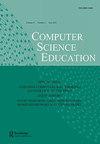Affordances and limitations of teachers instructional styles when teaching computer science and computational thinking
IF 2.2
Q1 EDUCATION & EDUCATIONAL RESEARCH
引用次数: 0
Abstract
ABSTRACT Background and Context There is a need for teachers who are prepared to teach integrated CS/CT throughout the K-12 curriculum. Drawing on three vignettes of teacher instructional practice, we build on a growing body of literature around how teachers integrate CS/CT into their classrooms after attending CS/CT focused professional development. Objective We are interested in what different instructional approaches look like when elementary teachers engage in teaching CS/CT and what kinds of discourse accompany each of these instructional approaches. Method We utilized a two-step process to code video data of classroom instruction for four teachers. We conducted macro level coding to gain an understanding of the types of knowledge, instructional strategies, and discourse displayed by each teacher. We then conducted micro-level discourse analysis utilizing Brennan and Resnick’s framework for assessing the development of computational thinking. Findings We present vignettes of teachers using three distinct instructional approaches, direct instruction, discovery learning, and scaffolding and modeling. We look across vignettes to discuss the affordances and limitations of each instructional approach. Implications Our findings have implications for how we design curriculum and instruction and conduct CS/CT professional development for K-12 teachers who will integrate CS/CT with other subjects.计算机科学与计算思维教学中教师教学风格的承受与局限
摘要背景和背景需要准备在整个K-12课程中教授综合CS/CT的教师。根据教师教学实践的三个小插曲,我们建立在越来越多的文献基础上,这些文献围绕着教师在参加以CS/CT为重点的专业发展后如何将CS/CT融入课堂。目的我们感兴趣的是,当小学教师参与CS/CT教学时,不同的教学方法是什么样子的,以及每种教学方法都伴随着什么样的话语。方法采用两步程序对四位教师的课堂教学视频数据进行编码。我们进行了宏观层面的编码,以了解每位教师所展示的知识类型、教学策略和话语。然后,我们利用Brennan和Resnick的框架对计算思维的发展进行了微观层面的话语分析。研究结果我们展示了教师使用三种不同的教学方法的小插曲,即直接教学、发现学习、支架和建模。我们通过小插曲来讨论每种教学方法的可供性和局限性。启示我们的研究结果对我们如何为K-12教师设计课程和教学以及进行CS/CT专业发展具有启示,这些教师将CS/CT与其他科目相结合。
本文章由计算机程序翻译,如有差异,请以英文原文为准。
求助全文
约1分钟内获得全文
求助全文
来源期刊

Computer Science Education
EDUCATION & EDUCATIONAL RESEARCH-
CiteScore
6.90
自引率
3.70%
发文量
23
期刊介绍:
Computer Science Education publishes high-quality papers with a specific focus on teaching and learning within the computing discipline. The journal seeks novel contributions that are accessible and of interest to researchers and practitioners alike. We invite work with learners of all ages and across both classroom and out-of-classroom learning contexts.
 求助内容:
求助内容: 应助结果提醒方式:
应助结果提醒方式:


